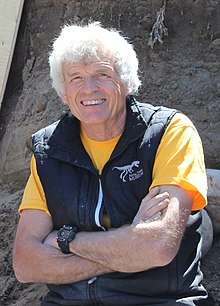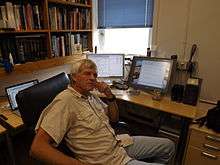Philip J. Currie
Philip John Currie AOE FRSC (born March 13, 1949) is a Canadian palaeontologist and museum curator who helped found the Royal Tyrrell Museum of Palaeontology in Drumheller, Alberta and is now a professor at the University of Alberta in Edmonton. In the 1980s, he became the director of the Canada-China Dinosaur Project, the first cooperative palaeontological partnering between China and the West since the Central Asiatic Expeditions in the 1920s, and helped describe some of the first feathered dinosaurs.[2][3] He is one of the primary editors of the influential Encyclopedia of Dinosaurs,[4] and his areas of expertise include theropods (especially Tyrannosauridae), the origin of birds, and dinosaurian migration patterns and herding behavior.[1] He was one of the models for palaeontologist Alan Grant in the film Jurassic Park.[5]
Phil Currie | |
|---|---|
 Currie in 2014 | |
| Born | March 13, 1949[1][2] Brampton, Ontario, Canada[2] |
| Alma mater | |
| Known for | Dinosaurs |
| Spouse(s) | Eva Koppelhus |
| Scientific career | |
| Fields | Paleontology |
| Institutions | |
| Thesis | The Osteology and Relationships of Aquatic Eosuchians from the Upper Permian of Africa and Madagascar (1981) |
| Doctoral advisor | Robert L. Carroll |
| Website | uofa |
Biography
Currie received his Bachelor of Science degree from the University of Toronto in 1972, a Master of Science degree from McGill University in 1975, and a Doctor of Philosophy (PhD) degree in biology (with distinction) from the same institution in 1981.[6] His master's and PhD theses were on synapsids and early aquatic diapsids respectively.[3]
Currie became curator of earth sciences at the Provincial Museum of Alberta (which became the Royal Alberta Museum in 2005) in Edmonton in 1976 just as he began the PhD program. Within three seasons he had so much success at fieldwork that the province began planning a larger museum to hold the collection. The collection became part of the Tyrrell Museum of Palaeontology, which was completed in 1985 (the "Royal" epithet was added in 1990),[3] and Currie was appointed curator of dinosaurs.[2]
In 1986, Currie became the co-director of the joint Canada-China Dinosaur Project, with Dale Russell of the Canadian Museum of Nature in Ottawa and Dong Zhiming of the Institute of Vertebrate Paleontology and Paleoanthropology in Beijing.[3]
Contributions to palaeontology
Over the last 25 years he has worked on fossil discovery in Mongolia, Argentina, Antarctica, Dinosaur Provincial Park, Dry Island Buffalo Jump Provincial Park, and many other locations.
His contributions to palaeontology include synonymising the genera Troodon and Stenonychosaurus in 1987 (with the former name taking precedence) and later reversing this in 2017. The similarities between troodontids and birds made him a major proponent of the theory that birds are descended from dinosaurs.[5]
As part of the joint China-Canadian Dinosaur Project he helped describe two of the first dinosaur specimens from the lagerstätten of the Liaoning in China that clearly showed feather impressions: Protarchaeopteryx[7][8] and Caudipteryx.[8] In contrast with the 1996 discovery of Sinosauropteryx, which only showed the impression of downy filaments, these were indisputably feathers.[5] This not only helped cement the theory that birds are descended from dinosaurs, but indicated that many dromaeosaurids were feathered.[9] He was later featured in numerous popular articles and documentaries.
In 1997, Currie teamed up with Microsoft's Chief Technical Officer Nathan Myhrvold to create a computer model demonstrating that diplodocids could snap their tails like whips, and create small sonic booms.[10] He was involved in exposing a composite specimen that had been the subject of the 1999 National Geographic "Archeoraptor" scandal.[11]
Currie became increasingly sceptical of the orthodox belief that large carnivorous dinosaurs were solitary animals, but there was no evidence for his hypothesis that they may have hunted in packs. However, circumstantial evidence came when he tracked down a site mentioned by Barnum Brown that featured 12 specimens of Albertosaurus from various age groups.[12]
In 2015, Currie contributed to a comprehensive revision of the phylogenetic relationships of ankylosaurid species.[13]
Philip J. Currie Dinosaur Museum
In 2015, the Philip J. Currie Dinosaur Museum was opened in Wembley, Alberta. It is located about a 15-minute drive west of Grande Prairie, and about 500 kilometres (310 mi) northwest of Edmonton. The museum was designed by Teeple Architects, and has won several awards. It celebrates the Pipestone Creek bone bed, one of the world's richest dinosaur-bearing bone beds.[14]
Personal life

Currie is a lifelong fan of science-fiction and the works of Edgar Rice Burroughs. He is married to the Danish palaeobotanist and palynologist Eva Koppelhus,[15] and has three sons from a previous marriage.
Awards and recognition
- 1981: Doctoral thesis nominated for the Canadian Society of Zoologist's best thesis of the year[3]
- 1988: Sir Frederick Haultain Award for significant contributions to science in Alberta[1]
- 1998: Featured as one of 12 outstanding Canadians in Maclean's[16]
- 1998: Featured on the front cover of the Canadian issue of Time[5][9]
- 1999: The American Association of Petroleum Geologists' Michel T. Halbouty Human Needs Award[1]
- 1999: Elected to the Royal Society of Canada[3]
- 2001: The festschrift Mesozoic Vertebrate Life: New Research Inspired by the Paleontology of Philip J. Currie was published in his honor[3]
- 2003: Ranked as one of Canada's top five explorers by Time magazine[1]
- 2004: Michael Smith Award[1]
- 2006: ASTech Award[1]
- 2010: Alberta Order of Excellence
- 2012: The Royal Canadian Geographical Society's Gold Medal[17]
- 2019: The Elizabeth 'Betsy' Nicholls Award for Excellence in Palaeontology[18]
Dinosaur species named in honour of Currie include Quilmesaurus curriei (Coria, 2001), Epichirostenotes curriei (Sullivan et al., 2011), Teratophoneus curriei (Carr et al., 2011), Philovenator curriei (Xu et al., 2012), and Albertavenator curriei (Evans et al., 2017).
Bibliography
As one of the world's foremost palaeontologists, Currie has been featured in many films, programs in radio and television, as well as in newspapers.[19] Apart from this, he has also been accessorial to many books:
- (with Carpenter K); Dinosaur Systematics: Approaches and Perspectives (Cambridge University Press, 1990), ISBN 0-521-43810-1.
- (with Sovak J); The flying dinosaurs: the illustrated guide to the evolution of flight (Red Deer College Press, 1991).
- (with Spinar V.Z. & Sovak J); Great Dinosaurs: From Triassic Through Jurassic to Cretaceous (Borders Press, 1994).
- (with Koppelhus E.B.); 101 Questions about Dinosaurs, (Dover Publications, 1996) ISBN 0-486-29172-3.
- (with Padian K); Encyclopedia of Dinosaurs (Academic Press, 1997) ISBN 0-12-226810-5.
- (with Mastin C.O. & Sovak J); The Newest and Coolest Dinosaurs (Grasshopper Books, 1998).
- (with Tanka S, Sereno P.J. & Norell M); Graveyards of the dinosaurs: what it's like to discover prehistoric creatures (Hyperion Books for Children, 1998).
- (with Sovak J & Felber E.P), A Moment in Time with Troodon (Fitzhenry & Whiteside, 2001).
- (with Koppelhus E.B. & Sovak J); A Moment in Time with Sinosauropteryx (Fitzhenry & Whiteside, 2001).
- (with Felber E.P. & Sovak J); A Moment in Time with Albertosaurus (Troodon Productions, 2001).
- (with Koppelhus E.B. & Sovak J); A Moment in Time with Centrosaurus (Fitzhenry & Whiteside, 2001).
- (with Koppelhus E, Orsen M.J., Norell M, Hopp T.P., Bakker R et.al); Feathered Dragons: Studies on the Transition from Dinosaurs to Birds (Indiana University Press, 2004) ISBN 0-253-34373-9.
- (with Špinar Z.V., Spinar V.S. & Sovak J); The Great Dinosaurs: A Study of the Giants' Evolution (Caxton Editions, 2004).
- (with Koppelhus E.B.); Dinosaur Provincial Park: a spectacular ancient ecosystem revealed, Vol. 1 (Indiana University Press, 2005) ISBN 0-253-34595-2.
- (with Tanke D.H. & Langston W); A new horned dinosaur from an Upper Cretaceous bonebed in Alberta (NRC Research Press, 2008).
Selected works
- Currie, Philip J. (ed.) (1993). "Results from the Sino-Canadian Dinosaur Project". Canadian Journal of Earth Sciences. 30 (10): 1997–2272. doi:10.1139/e93-175.CS1 maint: extra text: authors list (link)
- Currie, Philip J. (ed.) (1996). "Results from the Sino-Canadian Dinosaur Project, Part 2". Canadian Journal of Earth Sciences. 33 (4): 511–648. doi:10.1139/e96-040.CS1 maint: extra text: authors list (link)
References
- "Biographies: Born 1949–1954". Calgary Herald. June 8, 2008. Archived from the original on June 27, 2008. Retrieved July 2, 2008.
- "Currie, Philip J". The Canadian Encyclopedia. Historica Foundation. Retrieved July 2, 2008.
- Tanke, Darren; Carpenter, Ken, eds. (2001). Mesozoic Vertebrate life: New Research Inspired by the Paleontology of Philip J. Currie. Indiana University Press. ISBN 978-0-253-33907-2.
- Currie, Philip J.; Padian, Kevin, eds. (1997). Encyclopedia of Dinosaurs. Academic Press. ISBN 978-0-12-226810-6.
- Purvis, Andrew (July 6, 1998). "Call Him Mr. Lucky". Time. 151 (26): 52–55. Archived from the original on January 12, 2005. Retrieved April 3, 2015.
- "Dr. Philip J Currie > Professor". Faculty of Science. University of Alberta Department of Biological Sciences. August 17, 2006. Retrieved July 2, 2008.
- Ji Qiang; Ji Shu-An (1997). "A Chinese archaeopterygian, Protarchaeopteryx gen. nov". Geological Science and Technology (Di Zhi Ke Ji). 238: 38–41.. Translated by the Will Downs Bilby Research Center, Northern Arizona University, 2001.
- Ji Qiang; Currie, Philip J.; Norell, Mark A.; Ji Shu-An (June 25, 1998). "Two feathered dinosaurs from northeastern China" (PDF). Nature. 393 (6687): 753–762. doi:10.1038/31635. Archived from the original (PDF) on December 17, 2008.
- Lemonick, Michael D. (July 6, 1998). "Dinosaurs of a Feather". Time. 151 (26): 48–50. Retrieved July 3, 2008.
- Myhrvold, Nathan P.; Currie, Philip J. (1997). "Supersonic sauropods? Tail dynamics in the diplodocids". Paleobiology. 23 (4): 393–409. doi:10.1017/S0094837300019801.
- Sloan, Christopher P. (November 1999). "Feathers for T. rex". National Geographic. 196 (5): 98–107.
- "Extreme Dinosaurs". 2000.
- Arbour, Victoria M.; Currie, Philip J. (2015). "Systematics, phylogeny and palaeobiogeography of the ankylosaurid dinosaurs". Journal of Systematic Palaeontology. 14 (5): 385–444. doi:10.1080/14772019.2015.1059985.
- Jones, Jenny (August 5, 2015). "Philip J. Currie Dinosaur Museum". Architect Magazine.
- "Dino Hunter". Discover.
- Bergman, B. (December 21, 1998). "Maclean's honour roll: Philip Currie". Maclean's: 65.
- Mertl, Steve (November 7, 2012). "Dan Aykroyd taking a big interest in Canuck dinosaurs – but not of the film variety".
- "Dig Deep: A Gala Fundraiser & The Betsy Nicholls Award". Canadian Fossil Discovery Centre. Retrieved April 18, 2019.
- "Honorary Degrees: 2008 Recipients of Honorary Degree", University of Calgary homepage.
External links

- Currie at the Canada Encyclopedia